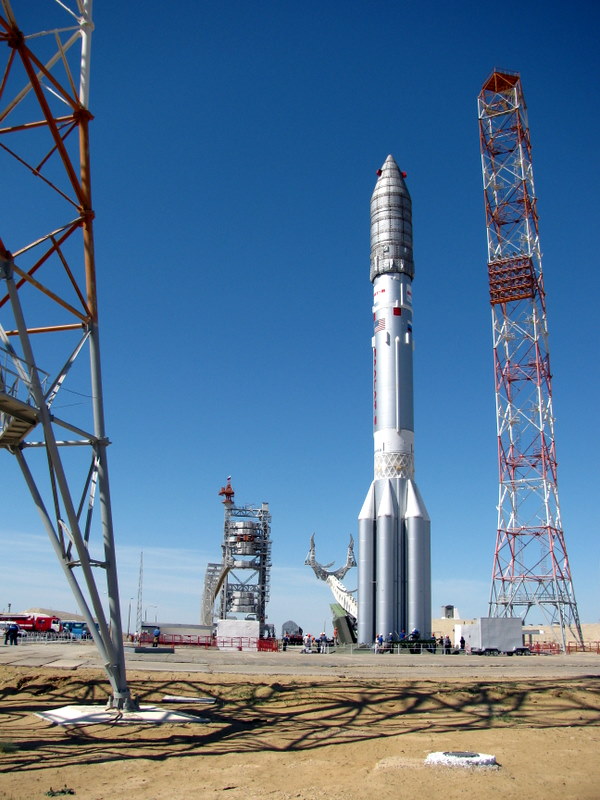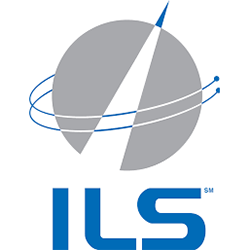Proton

Proton-M rocket preparing to launch the BADR-5 (Arabsat-5B) satellite, May 2010. The Proton is the largest Russian launch vehicle. It is capable of launching heavy space station components to LEO or carrying satellites directly to geostationary orbit. Since the mid 1990s it has been marketed by International Launch Services (ILS), a joint venture between Khrunichev Space Center and RSC Energia of Russia and Lockheed Martin of the United States.
About International Launch Services
International Launch Services
1875 Explorer Street, Suite 700
Reston, VA 20190
+! 571-633-7400
+1 571-633-7500 fax
Web site: www.ilslaunch.com
Jim Bonner
Chief Technical Officer and Vice President Programs
Phone: +1 (571) 633-7457
Fax: +1 (571) 633-7536
j.bonner@ilslaunch.com
Wendy Mihalic
Vice President, Marketing, Sales and Communications
Phone: +1 (571) 633-7452
Fax: +1 (571) 633-7576
w.mihalic@ilslaunch.com
Proton Vehicle Descriptions
General Description

Proton-M rocket prepared for launch. Launch campaign BADR-5 (Arabsat-5B). Courtesy Pavel Kolotilov
National Origin
RussiaMain Organization
Summary
Flight Rate
Estimated Launch Price
Retired.
Spaceports
| Launch Site | Baikonur LC 81 Pads 23 and 24 and LC 200 Pad 39 |
| Location | 46.1° N, 63.0° E |
| Available Inclinations | 51.6, 64.8, and 72.7 deg directly. All others require plane change maneuvers. |
Primary Missions
Three stage: space station deployment
Four stage: Heavy GEO payloads, planetary missions, GLONASS deployment
Status
Key Organizations
Marketing Organization
Launch Service Provider
Prime Contractor
Performance
Adapter mass must be subtracted to determine separated spacecraft mass. Performance reflects commercial configuration and flight profile. Maximum performance for Russian government missions is higher. See Performance section for more details.
| 200 km (108 nmi), 51.6 deg | 19,760 kg (43,560 lbm) |
| 185 km (100 nmi), 90 deg | 3620 kg (7980 lbm) |
| Space Station Orbit: 186×222 km (100×120 nmi), 51.6 deg | 19,760 kg (43,560 lbm). The three-stage Proton delivers spacecraft to low orbit, then the spacecraft must use onboard propulsion to raise the orbit to space station altitude. |
| Sun-Synchronous Orbit: 800 km (432 nmi), 98.6 deg | 3620 kg (7980 lbm) |
| GTO: 1500 m/sec Delta-V to 650 | 4350 kg (9590 lbm)—two upper-stage burns 4930 kg (10,846 lbm)—three upper-stage burns |
| Geostationary Orbit | 1880 kg (4145 lbm) |
General Description

Proton-M rocket prepared for launch. Launch campaign BADR-5 (Arabsat-5B). Courtesy Pavel Kolotilov
National Origin
RussiaMain Organization
Summary
Flight Rate
Estimated Launch Price
Retired.
Spaceports
| Launch Site | Baikonur LC 81 Pads 23 and 24 and LC 200 Pad 39 |
| Location | 46.1° N, 63.0° E |
| Available Inclinations | 51.6, 64.8, and 72.7 deg directly. All others require plane change maneuvers. |
Primary Missions
Three stage: space station deployment
Four stage: Heavy GEO payloads, planetary missions, GLONASS deployment
Status
Key Organizations
Marketing Organization
Launch Service Provider
Prime Contractor
Performance
Adapter mass must be subtracted to determine separated spacecraft mass. Performance reflects commercial configuration and flight profile. Maximum performance for Russian government missions is higher. See Performance section for more details.
| 200 km (108 nmi), 51.6 deg | 19,760 kg (43,560 lbm) |
| 185 km (100 nmi), 90 deg | 3620 kg (7980 lbm) |
| Space Station Orbit: 186×222 km (100×120 nmi), 51.6 deg | 19,760 kg (43,560 lbm). The three-stage Proton delivers spacecraft to low orbit, then the spacecraft must use onboard propulsion to raise the orbit to space station altitude. |
| Sun-Synchronous Orbit: 800 km (432 nmi), 98.6 deg | 3620 kg (7980 lbm) |
| GTO: 1500 m/sec Delta-V to 650 | 4350 kg (9590 lbm)—two upper-stage burns 4930 kg (10,846 lbm)—three upper-stage burns |
| Geostationary Orbit | 1880 kg (4145 lbm) |
